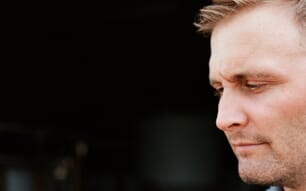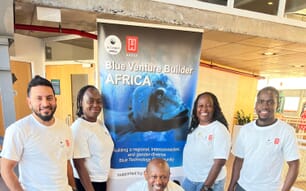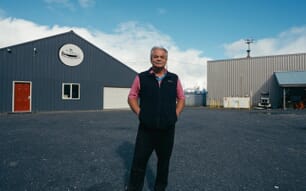Identity
Mercenaria mercenaria Linnaeus, 1758 [Veneridae]
FAO Names: En - Northern quahog (Hard clam), Fr - Praire, Es - Chirla mercenaria

Biological features
Shell solid, equivalve; inequilateral, beaks in the front half of the shell; broadly oval in outline. Ligament a deeply inset, dark brown elliptical band, behind the beaks reaching half-way to the posterior margin. Lunule well defined, broad, heart-shaped. Escutcheon indistinct. Sculpture of concentric lines, raised here and there into ridges, and fine radiating lines. In young specimens the ridges are present all over the shell but in the adult they persist, after wear and tear, only near the anterior and posterior margins. Growth stages prominent. Both valves with three cardinal teeth; in addition there is present in each valve a rough tooth-like area behind the beaks and immediately below the ligament; this area has the appearance of a supplementary posterior cardinal tooth which has been broken off. No laterals. Pallial sinus not deep, triangular. Margin grenulate. Colour a dirty white, light varnish-brown, dull grey or grey-brown. Inside of shell white, sometimes deep violet about the adductor muscle scars.
View SIDP Species fact sheet
Images gallery
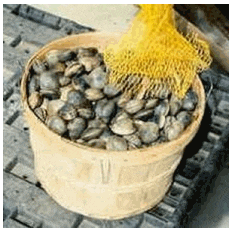
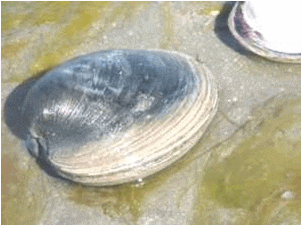
Profile
Historical background
There are two important factors that make the hard clam relatively unique as a farmed bivalve mollusc. The first is that it is more valuable at a small size; it stays in this size range for a relatively short period of time, after which the value decreases. The second aspect is related to hard clam biology, and makes it distinct from most other bivalves currently in large scale aquaculture; the hard clam does not typically produce concentrated sources of seed that can be collected from wild sets. The lack of seed necessitated the development of hatchery and nursery technology before critical experiments on field grow-out could take place. The development of relatively low-cost unicellular algal production techniques made production of large numbers of seed economically viable.
Experiments started in the late 1940s and the hatchery technology was developed in the early 1950s. By the end of that decade a number of individuals were attempting to grow the species commercially. Most of these early attempts were failures because predators consumed the seed, but limited numbers of clams were sold. In the 1970s a series of size-specific plantings of clam seed with a variety of protection techniques were instituted. The resulting data provided the science-based criteria for the further development of the nursery systems that needed to produce the size of seed for field operations.
Once large quantities of seed at the critical size of about 10 mm could be produced, several entrepreneurs learned the protection techniques (in the late 1970s and early 1980s) and, by the late 1970s, significant hard clam production through aquaculture had begun in the states of Massachusetts, New Jersey and North Carolina, United States of America. These pioneers spread the technology throughout the US east coast and modifications were made to the protection devices. By the late 1980s, hard clam aquaculture was being practiced from Massachusetts through Florida, but the bulk of production was in Massachusetts, Connecticut, New York, New Jersey, Virginia, South Carolina and Florida. These states have continued to be the largest producers, with Florida and Virginia becoming increasingly important in recent years.
Main producer countries
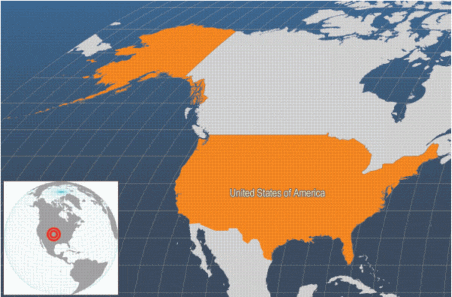
Habitat and biology
The native range of the species is from the Gulf of St. Lawrence in Canada through the northern Gulf of Mexico to Texas. It has been introduced to the west coast of the US (Washington and California), the island of Puerto Rico in the Caribbean region, the United Kingdom, France, Holland and Belgium in Europe, and Taiwan Province of China in Asia. Some individuals are also being reared in Wenzhou and Yantai in China.
Hard clams can be found in coastal lagoons and estuaries, they grow from 10-30 °C, but most growth occurs from 18-25 °C; below 5 °C clams become dormant. Clams burrow from just below the surface to about 15 cm in all sediment types, near oyster reefs, and in sea grass beds, but prefer sediments that are a mixture of sand and mud with some coarse material. They range from the intertidal zone to 15 m. Hard clams filter the water to obtain phytoplankton and other suspended particles that they use as food.
The hard clam has a typical bivalve life history. The sexes are separate, sperm and eggs are released into the water, and fertilization is external. The free swimming larvae feed on phytoplankton and other organic materials in the water for 7-21 days and then metamorphose into benthic organisms. These newly settled organisms attach to sediment with a byssal thread and develop a calcified shell within a day or so. The seed reach approximately 10-15 mm in year 0, and approximately 25-30 mm shell length (SL) by the end of year 1, but there is a large variability in growth. Individuals may develop sperm in year 0, but sexual maturation typically occurs by the end of year 2 or 3. Mature females typically spawn 1- 5 million eggs per spawning event, but may produce 40 million or more eggs per year.
Commercial size is reached at the end of the second year of life, or earlier in southern waters, but may take four or five years in the northern parts of the range. During the first year of life the animals are subject to high losses from invertebrate and vertebrate predators, chiefly crabs. They become less susceptible to predators when they reach 20-25 mm SL, and only large crustaceans (lobsters), large snails, a few fish and birds can consume mature hard clams. The average life span has been estimated to be between 12-20 years, but clams older than 50 years have been reported.
The major difference in the life history of hard clams compared to most bivalves is that large quantities of seed are not typically found in nature. This has caused hard clam aquaculture to rely entirely on hatcheries for seed. Much of the farming of this species is conducted in habitats with a significant mud component, both because of the availability of such sites and because this habitat eliminates some predators.
Production
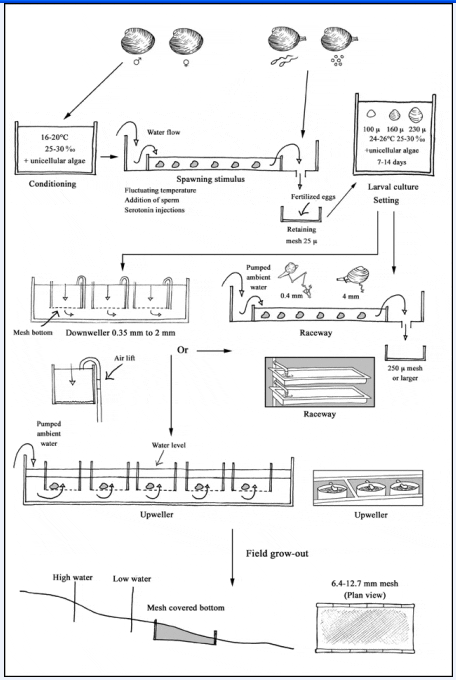
Production systems
Hard clam production systems range from intensive (hatchery, nursery and some grow-out) to extensive (some grow-out).
Seed supply
All hard clam seed are produced in hatcheries. The production cycle begins with adult organisms with well-developed gonads. The conditioning of these adults relies on a number of techniques. For early spawning, adults may be conditioned in the hatchery facility by increasing water temperature while providing sufficient food in the form of unicellular algae. Conditioning takes 4 to 10 weeks depending on the starting point. Clams may also be placed in high growth areas and allowed to condition naturally for spawning later in the season.
Typically, conditioned adults are mass spawned by placing them in a seawater bath in which temperature can be adjusted. Sperm, microalgae, or serotonin may be used to provide a stimulus for gamete release. Fertilized eggs are retained on a screen, then counted and distributed into tanks for development. After two days the larvae have reached the straight hinge stage and are removed from the tank, redistributed into another tank, and supplied with unicellular algal food. This process is repeated for 7 to 14 days until settling (setting), when clams are typically held at about 1/ml. Clams are removed from the larval tanks and placed in containers with mesh bottoms in which water with unicellular algae enters from the top (downwellers) or placed directly on raceways and supplied with very low flow. The clams remain in downwellers or with limited flow for one to two weeks. Clams in downwellers are then placed in mesh bottom containers with the water flowing up through the seed (upwellers).
Nursery
There is no definitive moment at which the hatchery system ceases and the nursery ensues. However, most people consider the point at which unicellular algae are no longer supplied as the end of the hatchery part of the cycle. At this point the clams feed exclusively on materials in the natural water being pumped from a nearby estuary. Clams usually remain in upwellers until they reach from 2-5 mm SL and then they are distributed into raceways, mesh bags in the field, or kept in upwellers where they grow to planting size (8-15 mm SL).
Ongrowing techniques
Clams are planted in plots in the intertidal or shallow subtidal zones. In most areas these are covered with a plastic mesh (6.4 or 12.7 mm square mesh) to prevent predation losses. In some locations clams are planted in mesh bags which are staked to the bottom. Plot maintenance involves regular (at least weekly) monitoring to check the mesh for damage and to remove fouling. Clams reach market size in 1-1.5 years in southern waters and 2-4 years in more northern locations.
Harvesting techniques
Clams are harvested from the bags by picking up the bag, or removed from the plots by digging with a rake or by hand. All clams are size-graded, either by hand or with mechanical grader/counter machines, and those individuals that are too small to market are returned to a separate plot for additional growth.
Handling and processing
Almost all farmed clams are sold live in the shell.
Production costs
Hard clam seed (10-12 mm size) typically cost from USD 25-30/1 000. The supply can be variable and many growers buy from multiple sources to hedge delivery times and supplies. Others buy smaller seed and operate their own nursery systems to grow the seed to planting size. Other costs are nominal, but include the cost of the mesh, any hold-down devices and ancillary field gear. The main costs other than the seed are the boat, its engine, and the labour required to tend the plots. Typically, survival to market in the plots averages 50-70 per cent. Below 50 per cent it becomes unprofitable to grow clams. Occasionally, survival exceeds 70 per cent, but that cannot be expected as routine.
Diseases and control measures
| DISEASE | AGENT | TYPE | SYNDROME | MEASURES |
|---|---|---|---|---|
| Vibriosis | Vibrio anguillarum; V. alginolyticus | Bacteria | Systemic infection of larval soft-tissues, resulting in tissue necrosis (due to production of exotoxin by the bacteria) & death | Good husbandry; sterilization of water used in algal and batch culture |
| Quahog Parasite Unknown Disease (QPX Disease); Chytrid-like Disease | - | - | Swellings and round yellow-tan nodules (1-5 mm in diameter) in mantle, often at edge & close to or directly adjacent to the siphon or adductor muscle; gills may also be infected; decrease in new shell growth; swollen, retracted, tan-coloured mantle edges; mucus & sand granules caught between swollen mantle & shell edges & high degree of chipping of the shell edge; can cause severe mortality | No control measure known, except planting resistant stocks |
Suppliers of pathology expertise
Expertise in clam pathology is similar to that for oysters, and exists primarily in academic institutions or governmental laboratories.
Statistics
Production statistics
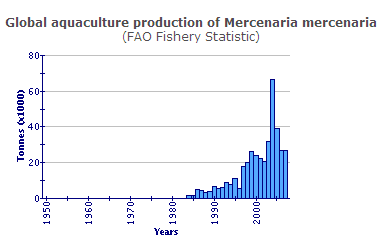
Significant commercial production in the US did not begin until the middle to late 1970s. There is little data available on production or sales from the early years because these were mixed with general landings from wild stocks. Taiwanese production of a species of Meretrix is recorded back to 1950 (750 tonnes) in FAO data as a hard clam. Farmed hard clam production data from the US first appear in this data source in 1984 (1 982 tonnes).
In that same year, Taiwan Province of China reported an output of 17 115 tonnes of Meretrix. By 1993, production in Taiwan Province of China had not expanded much since 1984 (17,438 tonnes) but US production of Mercenaria had risen to 8,856 tonnes. During the decade 1993-2002, the annual average growth rate of cultured hard clam has expanded faster in the USA (9.9 per cent/yr) than in Taiwan Province of China (6.5 per cent/yr). However, Taiwan Province of China is still the major producer (30 711 tonnes in 2002). Commercial output from France (a third species - the introduced Manila clam (Ruditapes philippinarum) was not reported until 2002 (250 tonnes).
Market and trade
The prime market for cultured hard clams is live in the shell. The product is used either fresh on the half shell, or steamed. The primary market for the half shell is as an appetizer in up-scale restaurants. Most clams are sold along the east coast of the US, but some are sold throughout the US into the mid-west. Very little of this product is sold outside the US. There have been attempts to produce a frozen in-the-shell product for home use as an ingredient in sauces used over pasta. This has been hindered by size regulations imposed on the harvest of wild clams by some states (see below).
Prices vary seasonally and according to the state of the economy. In recent years the price for the prime size (littleneck) clams has varied from USD 0.12-0.25. In US the primary market information is collected by the National Oceanographic and Atmospheric Agency, National Marine Fisheries Service. Daily summaries of prices by size are provided through a market service, but do not separate out aquaculture product from wild harvested hard clams. In addition, many of the cultured clams are sold outside these channels and are thus not captured by the official price or quantity statistics.
The only US Federal market regulations are those that are used to assure the health of the human consumers. These are enforced at the state level and are based on monitoring and classification of the growing waters. The only other regulations that apply to hard clams are those that limit the sale of small clams to protect the wild stocks. These regulations vary from state to state, but most frequently regulate the size based on the thickness of the clams to 1 inch (2.54 cm) and larger. The exception to this is for seed sales for aquaculture purposes.
China has recently imported a number of hard clams and there are at least two groups in that country experimenting with the culture of this species. It is highly likely that they will succeed with the culture aspects, but the nature of the prime hard clam market (live in the shell) may make exports to the US very difficult.
Status and trends
As noted above, the price of hard clams is very sensitive to the state of the economy; currently US markets are depressed relative to a few years ago. It is likely that hard clam production will continue to increase at a modest rate in the future. The primary impediments to continued expansion are government regulations, the shallow water requirement for most production practices and constraints on seed production. The shallow water habitat required for most techniques places hard clam culture in a highly visible location and in a zone where there can be interactions with sea grasses.
This combination greatly reduces the potential locations available for expansion. There are a few companies that are primarily seed producers, but there are a substantial number of producers that operate their own hatcheries. This scenario results in spot shortages of the prime sizes of seed in some years. While this trend will probably continue in the future, there have been companies in locations that can produce seed year around vying for market share. In spite of these difficulties, as the US economy improves there will be a general increase in prices and production. In addition, there will numerous small producers and the emergence of a number of large producers who can supply supermarket chains with a constant stream of products.
Research
Current research has focused on the links between QPX (see above) and various genetic strains. Additional research is being conducted on the development of tetraploid animals to provide genetic stocks for the development of triploid individuals. A limited number of small studies are ongoing to improve hatchery production, nursery efficiency and predator and fouling control.
Development prospects
The primary impediments to greater production in the US are:
- Price sensitivity to general economic forces.
- Local or annual spot shortages of larger seed.
- Most importantly, the difficulty in finding sites for new farms. This is primarily due to the requirement for shallow water that is dictated by current culture techniques. If an economical means of production could be developed for deep water sites, significantly more areas would be available for culture.
Market prospects
There is a need to develop a rigid size classification that is linked to named market sizes (littleneck, cherrystone, chowder, etc.) At present, when insufficient numbers of small sizes are available, the US market moves larger individuals into the smaller size class. This practice confuses the customer and lowers the price that could be charged in times of shortages.
Recommendations
Research is needed to increase the reliability of seed production. Efforts should be directed toward increasing survivorship of newly set individuals and developing methods to enhance growth rates. In the field, more research is needed to examine optimum plot sizes, planting densities, predator protection devices, and methods to grow seed and market individuals in deeper water.
As more and more of the smaller sizes become available through aquaculture activities, the differentiation noted above may be less important than opening new markets. There is appreciable room for research on market acceptance and market expansion but, because most growers are small enterprises, there is little incentive for the industry to fund such studies.
Main issues
There are few negative environmental impacts of hard clam aquaculture. The operations are typically in shallow water and occupy limited space within this heavily utilized zone. Leases are usually neither granted for areas that produce significant commercial quantities of wild clams nor allowed in areas of rooted vascular grass (seagrass) beds. There have been instances of conflict with seagrasses invading the area of clam farms. This apparently is because the mesh and clams stabilize the bottom, and the filtration activity of the clams increases water clarity. This combination allows for invasion of the farm by seagrasses. The filtration activity of the clams also deposits faecal and pseudofaecal materials on the bottom and may speed up the remineralization processes; this has been considered a positive impact of bivalve culture because it serves to remove nitrogen from the system.
Clearly the area occupied by clam farms is modified, compared to the surrounding sediments and may support a slightly different infaunal assemblage. While the numbers of individuals of particular species in this assemblage may differ from the nearby sediments, species composition is often not significantly altered. Clam farms typically have minimal sediment build up because large accumulations would cover the mesh and suffocate the clams. The accumulating sediments are typically dispersed over a large area because the intertidal nature of the planted sites makes them very susceptible to wind driven waves.
Responsible aquaculture practices
The meshes or bags used to protect the clams serve as a substrate and may develop extensive macroalgal or macrofaunal fouling communities. These may serve to increase species diversity in an otherwise apparently barren mud or sand flat. These fouling communities are periodically removed to prevent them stunting clam growth rate. In addition, harvesting the clams obviously completely disturbs the bottom. However, the farming activity is concentrated in small areas; the unit area disturbed per clam is therefore much less in aquaculture than in wild harvesting.
April 2010


